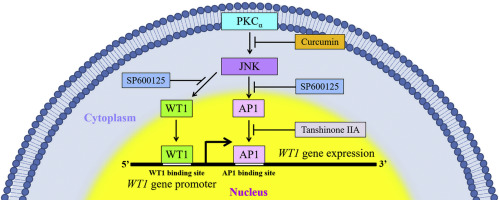当前位置:
X-MOL 学术
›
Cell. Signal.
›
论文详情
Our official English website, www.x-mol.net, welcomes your
feedback! (Note: you will need to create a separate account there.)
Co-activation of WT1 and AP-1 proteins on WT1 gene promoter to induce WT1 gene expression in K562 cells.
Cellular Signalling ( IF 4.4 ) Pub Date : 2018-11-03 , DOI: 10.1016/j.cellsig.2018.11.001 Songyot Anuchapreeda 1 , Methee Rungrojsakul 2 , Singkome Tima 3 , Sawitree Chiampanichayakul 3 , Sheryl R Krig 4
Cellular Signalling ( IF 4.4 ) Pub Date : 2018-11-03 , DOI: 10.1016/j.cellsig.2018.11.001 Songyot Anuchapreeda 1 , Methee Rungrojsakul 2 , Singkome Tima 3 , Sawitree Chiampanichayakul 3 , Sheryl R Krig 4
Affiliation

|
Earlier studies have revealed one function of the inhibitory mechanism of curcumin. Activating PKCα induces WT1 gene expression via signalling through downstream JNK and c-JUN. In the present study, the effect of c-JUN/AP-1 binding and transcriptional regulation of the WT1 gene promoter was investigated in K562 leukaemic cells. The non-cytotoxic dose (IC20 values) of curcumin (WT1 and AP-1 inhibitors) was employed to examine its effect on WT1 gene-mediated WT1 and AP-1 protein expression. Non-cytotoxic doses of both tanshinone IIA (AP-1 DNA-binding inhibitor) and SP600125 (JNK inhibitor) were used to test the role of c-JUN/AP-1 in WT1 gene expression. Curcumin, tanshinone IIA, and SP600125 inhibited WT1 protein expression in a dose-dependent manner (5-15 μM) at 24 h as shown by immunoblotting. A ChIP assay showed that curcumin and tanshinone IIA inhibited AP-1 and WT1 binding to the proximal WT1 promoter (-301 bp), and a luciferase reporter assay showed that the WT1 luciferase gene reporter activity was decreased after curcumin, tanshinone IIA, and SP600126 treatments. Furthermore, depletion of c-JUN abrogated WT1 gene expression. In summary, AP-1 contributes to the WT1 autoregulation of WT1 gene expression in leukaemic K562 cells.
中文翻译:

WT1和AP-1蛋白在WT1基因启动子上的共激活,以诱导WT1基因在K562细胞中的表达。
早期的研究揭示了姜黄素抑制机制的一种功能。激活PKCα通过下游JNK和c-JUN的信号传导诱导WT1基因表达。在本研究中,在K562白血病细胞中研究了c-JUN / AP-1结合和WT1基因启动子转录调控的作用。用姜黄素(WT1和AP-1抑制剂)的非细胞毒性剂量(IC20值)来检查其对WT1基因介导的WT1和AP-1蛋白表达的影响。丹参酮IIA(AP-1 DNA结合抑制剂)和SP600125(JNK抑制剂)的非细胞毒性剂量均用于测试c-JUN / AP-1在WT1基因表达中的作用。姜黄素,丹参酮IIA和SP600125在24小时以剂量依赖性方式(5-15μM)抑制WT1蛋白表达,如免疫印迹所示。ChIP分析显示姜黄素和丹参酮IIA抑制AP-1和WT1与近端WT1启动子结合(-301 bp),萤光素酶报告基因检测结果显示,姜黄素,丹参酮IIA和SP600126导致WT1萤光素酶基因报告基因活性降低。治疗。此外,c-JUN耗竭废除了WT1基因表达。总之,AP-1有助于白血病K562细胞中WT1基因表达的WT1自动调节。
更新日期:2018-11-03
中文翻译:

WT1和AP-1蛋白在WT1基因启动子上的共激活,以诱导WT1基因在K562细胞中的表达。
早期的研究揭示了姜黄素抑制机制的一种功能。激活PKCα通过下游JNK和c-JUN的信号传导诱导WT1基因表达。在本研究中,在K562白血病细胞中研究了c-JUN / AP-1结合和WT1基因启动子转录调控的作用。用姜黄素(WT1和AP-1抑制剂)的非细胞毒性剂量(IC20值)来检查其对WT1基因介导的WT1和AP-1蛋白表达的影响。丹参酮IIA(AP-1 DNA结合抑制剂)和SP600125(JNK抑制剂)的非细胞毒性剂量均用于测试c-JUN / AP-1在WT1基因表达中的作用。姜黄素,丹参酮IIA和SP600125在24小时以剂量依赖性方式(5-15μM)抑制WT1蛋白表达,如免疫印迹所示。ChIP分析显示姜黄素和丹参酮IIA抑制AP-1和WT1与近端WT1启动子结合(-301 bp),萤光素酶报告基因检测结果显示,姜黄素,丹参酮IIA和SP600126导致WT1萤光素酶基因报告基因活性降低。治疗。此外,c-JUN耗竭废除了WT1基因表达。总之,AP-1有助于白血病K562细胞中WT1基因表达的WT1自动调节。









































 京公网安备 11010802027423号
京公网安备 11010802027423号